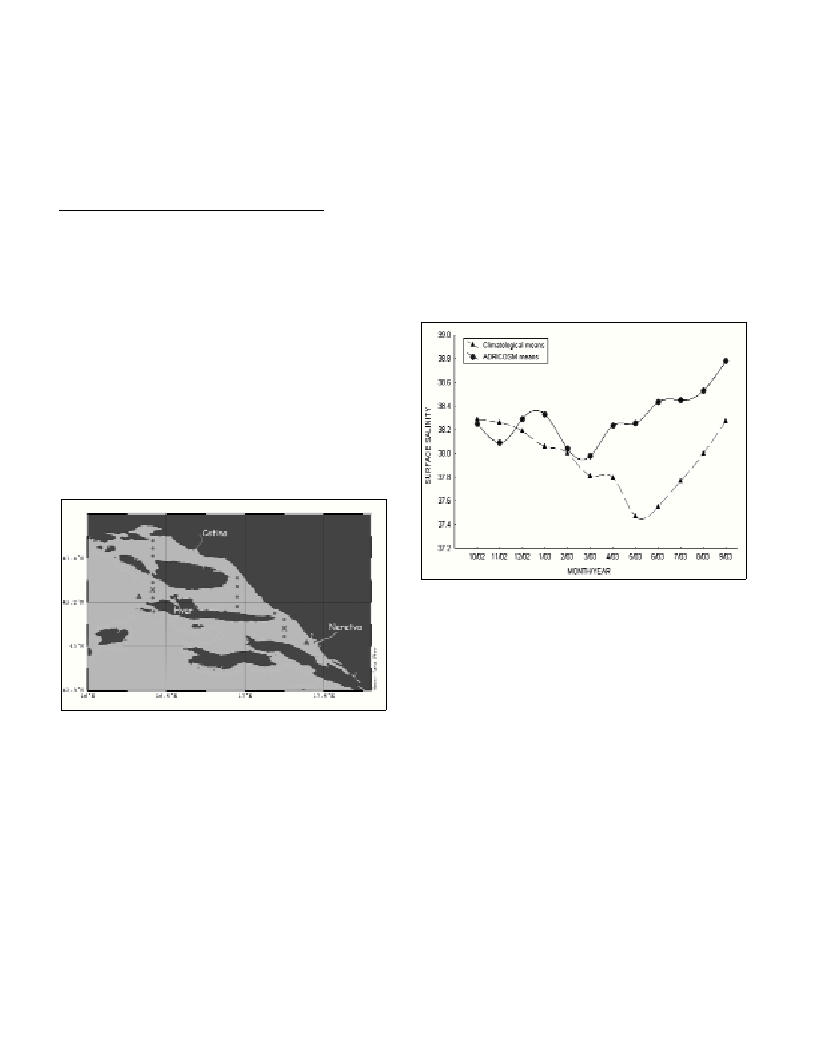Rapp. Comm. int. Mer Médit., 37,2004
105
UNUSUAL THERMOHALINE SEASONALITY IN THE MIDDLE ADRIATIC COASTAL WATERS
(OCTOBER 2002-SEPTEMBER 2003)
Grbec Branka*, Dadic Vlado, Beg Paklar Gordana, Morovic Mira and Matic Frano
Institute of Oceanography and Fisheries, Setaliste Ivana Mestrovica 63, 21000 Split, Croatia - * grbec@izor.hr
Abstract
Intensive experiment with weekly CTD measurements in the middle Adriatic coastal area was carried out from October 2002 until
September 2003. The first outlook of temperature and salinity space and time variability, together with departures from typical climatology
of the area is presented.
Keywords: thermohaline, coastal water, Adriatic Sea
Introduction
The middle Adriatic area has strong temporal variability of
thermohaline structure caused mainly by air-sea interaction, river
discharges, mixing and seasonally dependent circulation (1). In the
middle Adriatic coastal zone fresh water provides a strong buoyancy
source, while in the wider shelf-sea freshwater in?uence is dispersed.
The ADRICOSM (2) research area is pointed as a region where fresh
water input from the eastern Adriatic coast is observed, especially
from the Cetina and Neretva rivers, whereas in the offshore waters,
in?uence of the northern Adriatic rivers during the stratified period
might be significant. Spring and summer 2003 were warmer and drier
than usual, causing high temperatures and salinities with strong
departures from the local climatology.
Research area
Intensive be-weekly and weekly CTD profiling was carried out in
the period between October 2002 and September 2003 at 14 stations
in the channel area of the eastern middle Adriatic (Fig.1, stations
denoted by circle). Collected data set had good space and time
coverage for comparison with general thermohaline climatology of
the region.
Fig. 1. Location of CTD stations in ADRICOSM research area (denoted by
circles) and climatological stations (denoted by triangles).
Climatology of the research area was obtained from temperature
and salinity data collected between January 1961 and December 2000
in the offshore area in front of the west coast of Hvar Island and in the
vicinity of Neretva estuary (stations denoted by triangles). Uniform
salinity annual course has been found at depths up to 18 m at the near-
coastal stations. Spring salinity minimum coincide with Neretva
discharge maximum, whereas the second minimum in November is
caused by extensive precipitation. At the offshore stations, beside the
spring minimum, an additional summer minimum is observed in the
surface layer (Fig.2), probably caused by the spreading of low-
salinity water from the north.
Preliminary results
Project goals were to reveal the mechanisms responsible for typical
thermohaline variability and to determine the contribution of
horizontal and vertical processes to the total heat and salt exchange.
Spring and summer 2003 were warmer and drier than usually with
strong evaporation and minimum precipitation, which resulted in
exceptionally high salinity values at almost all stations. Temporal
salinity changes obtained during the experiment show strong
departures from typical annual cycle in which salinity follows E-P
variability. Throughout the whole experiment strong positive trend in
the salinity was observed (Fig.2). As a consequence of intensive
heating, sea surface temperatures became greater than long-term
means. High temperature gradient was observed between shallow
surface layer and layer bellow thermocline, which disappeared after
an episode of bura wind in the mid-September.
Fig. 2. Salinity monthly means for the station near the Hvar Island over
the 1961-2000 period compared to the monthly mean salinities obtained
in the Hvar channel during the ADRICOSM experiment from October 2002
to September 2003.
Acknowledgements.The contents of this article were developed
under a financial support from the Istituto Nazionale di Geofisica e
Vulcanologia, Italy, and funded under Italian Ministry for the
Environment contract ADRICOSM
References
1-Zore-Armanda, M., Grbec, B. and Morovic, M., 1999. Oceanographic
properties of the Adriatic Sea - a point of view. Acta Adriat., 40: 39-54.
2-ADRICOSM. The first year scientific report (unpublished paper).
INGV, Bologna.

